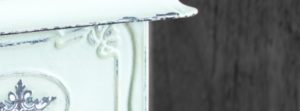There are a number of techniques that will ultimately give you the Vintage Look (someome require more creative flair than others). Here you will find five techniques explained, offering slightly different Vintage effects, so you can choose the technique that will achieve your desired result.
Sanding:
Paint the wood, furniture or object with Pintyplus Chalk spray paint. As always, apply thin layers and leave 5 minutes between coats. The last coat will require 20 minutes drying time.
Then gently rub over the surface with a damp cloth to remove any dust particles that have accumulated. With a soft sandpaper, rub the edges and detailed areas to make them look as though they have been worn by the passage of time. The original colour will show through, giving those areas the desired Vintage effect.
Rubbing:
Paint the object with Pintyplus Chalk paint, but do not wait for it to dry. With the paint still wet, use your fingers or palm of your hand to rub the paint in the areas you wish to create the appearance of wear. This paint is water-based and therefore safe to touch, but you might wish to wear protective gloves.
A softer edge to the worn areas is created with this technique as shown in the image of the finished article.
It is also possible to paint a base colour and allow it to completely dry before applying the top colour and using this effect, thus revealing the base colour in the worn areas.
Smearing:
The third option to create a Vintage feel to your object is to paint the item in the main colour, then stain the edges and reliefs in another colour/shade, by smearing the paint over the original colour with your fingers.
It is best to squeeze/spray the colour onto a plate or piece of card and with wet fingers or palm of the hand, rub them into the paint and apply to the object where desired.
Source: Javi De Yonolotiraria
Waxing:
This technique works in the opposite way. You apply classic furniture wax to the object in the areas you would like to look distressed. The paint will therefore not adhere in these areas.
You do have to imagine the result and improvise when applying the wax. Then apply the water-based paint and allow to dry for 20 minutes, before rubbing the surface confidently. The areas where the wax was applied will become exposed, creating the Vintage effect.
Blending:
This technique is used with Pintyplus Chalk Paint, by painting a base colour and allowing it to dry for 20 minutes. Then apply another chalk paint colour over the top and while still wet, use a brush dipped in water or a cotton bud dipped in water, to repeatedly brush over the wet paint until you have achieved the desired effect.
It creates an aged effect as shown in the image, where both colours are visible but appear softly blended.
Source: Bricoydeco






